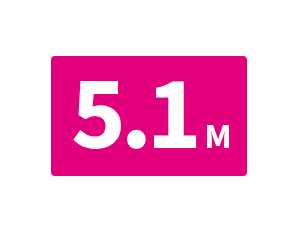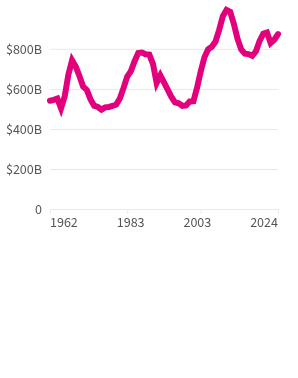What’s in Trump’s 2026 budget proposal?
The fiscal year 2026 budget proposal would keep base discretionary spending level.
A budget proposal sent from the Office of Management and Budget (OMB) to Congress details the Trump administration’s discretionary spending recommendations: The proposed FY 2026 budget keeps overall discretionary base spending level with 2025, but changes how some of that money is allocated, shifting $119.3 billion from non-defense programs to defense programs.
“Discretionary spending” refers to the portion of the budget that requires congressional approval — in other words, funding that is up to the discretion of Congress.
The rest is “mandatory spending,” funds spent automatically to cover required expenses under current law, including programs like Social Security and Medicare. Proposed changes to mandatory programs are not included in this data.
What was the total discretionary presidential budget request for 2026?
The president’s 2026 budget request included $1.69 trillion in discretionary spending split between what the OMB calls “base” and “non-base” funding. Base discretionary funding includes most spending through departments and agencies; non-base discretionary funding covers less predictable expenses like emergency and disaster relief.
Ninety-five percent of the request ($1.61 trillion) was base funding. This matches the total enacted for fiscal year 2025.
Changes to specific base funding allocations reflect shifting executive branch priorities in the early days of President Trump’s second term.
What does the 2026 budget proposal cut?
The administration proposed $119.3 billion less for base discretionary funding for non-defense programs, cutting 7.4% of all base discretionary funds.
State Department and international programs
The 2026 budget features an 83.7% cut to base discretionary funding for the State Department and international programs administered by other agencies (including USAID), taking funding from $58.7 billion to $9.6 billion. The largest proposed reductions in this area are in international economic and development aid (-$8.3 billion), global health and family planning programs (-$6.2 billion), and international disaster assistance (-$3.2 billion).
There are two programs within this category whose funding would increase:
- The America First Opportunity Fund, a new fund whose purposes include supporting American partners, including India and Jordan, and paying for immigrant repatriations, would receive $2.9 billion.
- The Development Finance Corporation, established during Trump’s first term to make strategic development investments around the world, would see a $2.8 billion increase.
Department of Housing and Urban Development (HUD)
The administration proposes a 43.6% decrease in HUD program funding, from $77.0 billion to $43.5 billion. This includes a $26.7 billion cut from federal rental assistance programs as the responsibility for rental assistance would shift to the states. The proposal also eliminates the $3.3 billion Community Development Block Grant program, designed to support community infrastructure, public facilities, and programming.

Department of Health and Human Services (HHS)
The Department of Health and Human Services budget would be reduced by 26.2%, from $127.0 billion to $93.8 billion. Within this, a new $500 million fund would support the “Make America Healthy Again” initiative, designed to allow HHS Secretary Robert F. Kennedy Jr. to address nutrition, medication, and food and drug quality.
A reform of the National Institutes of Health would reduce its budget by $18.0 million, requiring the closure of the National Institute on Minority and Health Disparities and the National Institute of Nursing Research. The Centers for Disease Control and Prevention budget would also drop $3.6 billion.
Another $4.0 billion would be cut by ending the Low Income Home Energy Assistance Program operated by the Administration for Children & Families.
Department of Education
The proposal reduces the Department of Education’s discretionary budget by 15.3%, from $78.7 billion to $66.7 billion, as the administration continues what it calls the shutdown of the department. The budget explains that it will streamline K–12 funding and shift spending decisions to states and districts, further reducing federal staff.
Other
While the State Department, HUD, HHS, and Education Department would have the largest proposed cuts in overall dollars, six other cabinet-level departments would also face reductions:
- Department of Labor, -34.9% ($13.3B to $8.6B)
- Department of the Interior, -30.5% ($16.8B to $11.7B)
- Department of the Treasury, -19.0% ($14.2B to $11.5B)
- Department of Agriculture, -18.3% ($27.3B to $22.3B)
- Department of Energy, -9.4% ($49.8B to $45.1B)
- Department of Justice, -7.6% ($36.0B to $33.2B)
There are also proposed reductions to non-cabinet agencies, including -55.8% from the National Science Foundation, -54.5% from the Environmental Protection Agency, -33.3% from the Small Business Administration, and -24.3% from NASA.
What does the 2026 budget proposal add?
The administration proposed increases to the budgets of four cabinet-level departments.
The largest increase by dollar amount is a $113.3 billion increase in base discretionary funding to the Department of Defense (DOD), which would take its funding from $848.3 billion to $961.6 billion. The DOD was allocated 52.6% of all base discretionary funding in fiscal year 2025; that would rise to 59.6%. The added funding is aimed at:
- Reducing spending on climate and DEI (diversity, equity, and inclusion) programs
- Developing a “Golden Dome for America” missile defense shield
- Building more military ships and next-generation fighter jets
- Supporting space defense
- Supporting border security
- Nuclear deterrence
- A 3.8% pay raise for armed service members

The largest percentage increase proposal is for the Department of Homeland Security (DHS), whose funding would increase 64.9% from $65.1 billion to $107.4 billion. In the administration’s words, this funding would go towards “fully implementing the President’s mass removal campaign,” among other administration priorities.
Within DHS, the proposal reduces funds for:
- Federal Emergency Management Agency (FEMA) grant programs (-$646 million)
- The Shelter and Services Program, which shelters migrants released by authorities in border communities (-$650 million)
- The Cybersecurity and Infrastructure Security Agency, eliminating programs on misinformation and propaganda (-$491 million)
- The Transportation Security Administration (-$247 million)
Beyond DOD and DHS, the proposed budget offers a $3.3 billion increase in funding for veteran healthcare through the Department of Veterans Affairs. The Department of Transportation would also see a 5.8% increase, mostly in infrastructure grants and targeted funds for Federal Aviation Administration operations and communications systems.
Read more about the federal budget and get the latest data in your inbox with our flagship newsletter.
